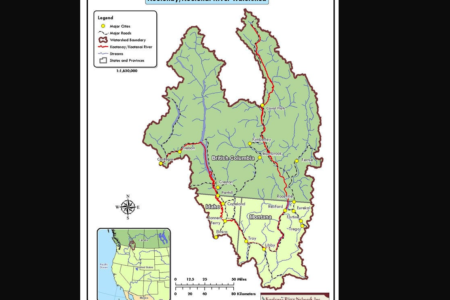Major rivers have enough water to sustain growing populations: report
By Yale Environment 360
A new study says the world’s major river systems contain more than enough water to meet global food production needs in the 21st century.
Following a five-year study of 10 river basins, including the Nile.
With global population expected to surpass 7 billion people this year, the staggering impact on an overtaxed planet is becoming more and more evident.
The world’s major rivers include the Ganges, Andes, Yellow, and Niger. Scientists with the Consultative Group on International Agricultural Research (CGIAR) found that the greatest water challenge facing the planet is not scarcity but the inefficient and inequitable distribution of water.
“Huge volumes of rainwater are lost or never used,” said Alain Vidal, director of CGIAR’s Challenge Program on Water and Food. In regions of sub-Saharan Africa, he said, even “modest” improvements in rainwater harvesting could yield two to three times more food production.
Elsewhere, regions in Asia and Latin America exist where food production could be increased by at least 10 per cent, according to the report, which is published in the journal Water International.
According to a recent UN report, global food output will have to increase 70 percent by 2050 to feed a growing world population.
Demographers aren’t known for their sense of humor, but the ones who work for the United Nations recently announced that the world’s human population will hit 7 billion on Halloween this year.
Since censuses and other surveys can scarcely justify such a precise calculation, it’s tempting to imagine that the UN Population Division, the data shop that pinpointed the Day of 7 Billion, is hinting that we should all be afraid, be very afraid.
We have reason to be. The 21st century is not yet a dozen years old, and there are already 1 billion more people than in October 1999 — with the outlook for future energy and food supplies looking bleaker than it has for decades.
It took humanity until the early 19th century to gain its first billion people; then another 1.5 billion followed over the next century and a half. In just the last 60 years the world’s population has gained yet another 4.5 billion. Never before have so many animals of one species anything like our size inhabited the planet.
And this species interacts with its surroundings far more intensely than any other ever has. Planet Earth has become Planet Humanity, as we co-opt its carbon, water, and nitrogen cycles so completely that no other force can compare.
For the first time in life’s 3-billion-plus-year history, one form of life – ours – condemns to extinction significant proportions of the plants and animals that are our only known companions in the universe.
- For more information: http://e360.yale.edu/feature/the_world_at_7_billion_can_we_stop_growing_now/2426/
























